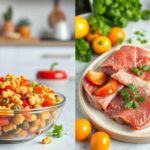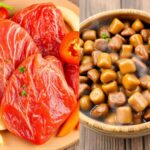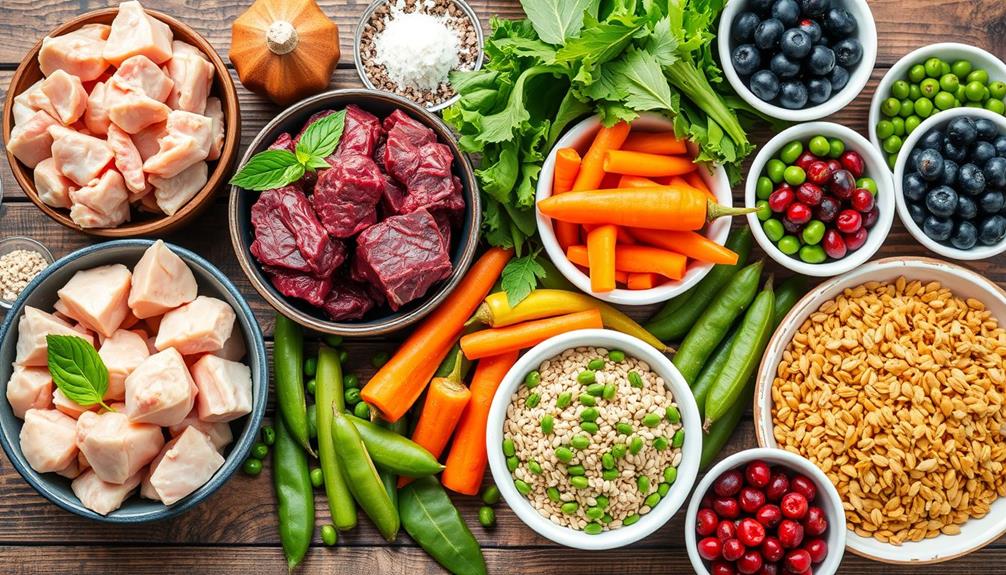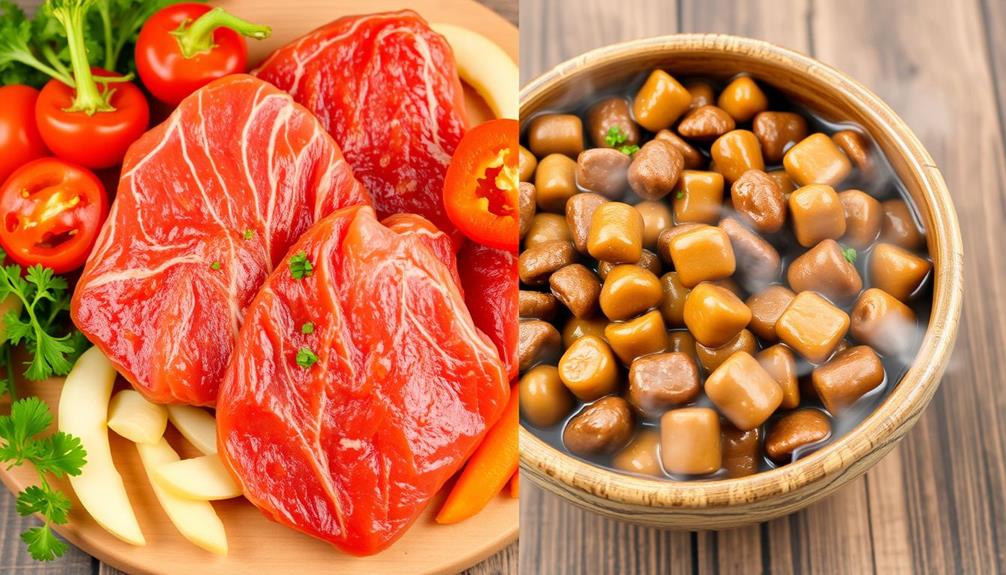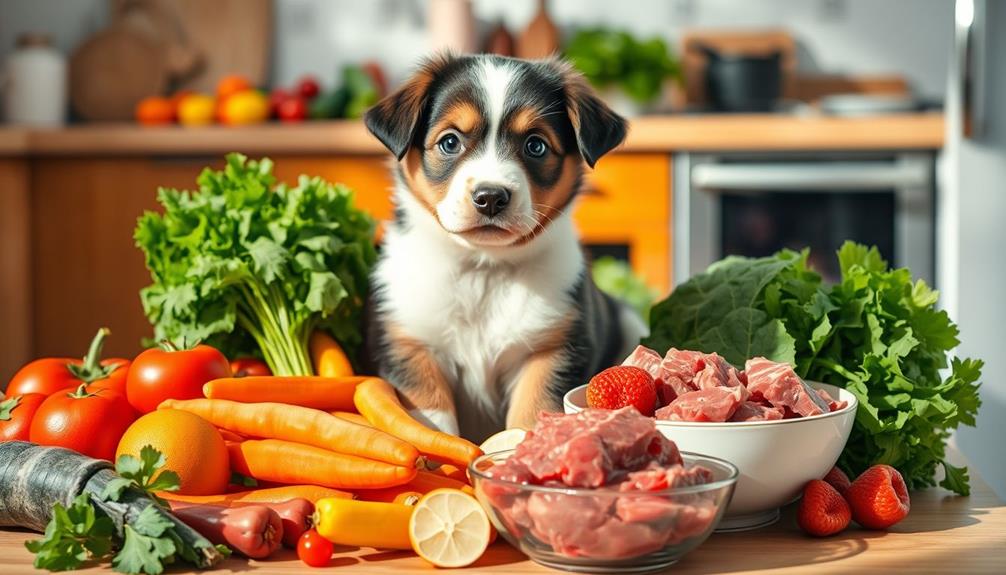When deciding between wet food and raw food for your dog, consider their individual needs. Wet food is great for hydration, easier digestion, and is often more palatable for picky eaters. It's usually nutritionally balanced but may have fewer nutrients than raw diets. On the other hand, raw food offers higher protein levels and better nutrient absorption, enhancing your dog's overall energy and health. However, it requires careful preparation to avoid risks like bacterial contamination. Each option has its pros and cons, so you'll want to assess what's best for your furry friend, and there's more to explore on this topic.
Key Takeaways
- Wet food provides high moisture content, aiding hydration and making it easier for picky eaters and dogs with dental issues to consume.
- Raw food diets typically offer higher protein levels and better nutrient absorption from fresh ingredients, enhancing overall health and energy levels.
- Both wet and raw diets require careful planning to ensure nutritional balance and avoid deficiencies, especially in raw diets.
- Wet food often adheres to AAFCO standards, while raw diets need tailored formulations to meet specific nutritional needs.
- Consulting with a veterinarian is essential before making dietary changes to address potential risks and ensure optimal health for your dog.
Understanding Dog Nutrition
When it comes to your dog's health, understanding nutrition is essential. A balanced dog diet must include key nutrients like protein, fats, carbohydrates, vitamins, and minerals to support overall health and wellbeing.
Your dog's nutritional needs can vary greatly based on age, breed, and activity level. Puppies, adults, and seniors each require different formulations to meet their specific requirements. Additionally, the key domains of development in psychology can be applied to understanding how dietary choices may influence a dog's overall growth and behavior.
You might consider a raw food diet, often called BARF (Bones and Raw Food), which emphasizes natural ingredients that mimic the diets of wild canines. However, this diet needs careful balancing of ingredients to guarantee nutritional adequacy.
On the other hand, wet food offers higher moisture content and is often more palatable for picky eaters, making it a great option for hydration. Both wet food and raw food can contribute to increased water intake compared to dry food options.
Ultimately, the choice between a raw food diet and wet food should focus on providing a balanced dog diet that meets your pet's unique nutritional needs. Regularly consulting with your veterinarian will help you make informed decisions for your furry friend's diet.
Benefits of Wet Dog Food

While wet dog food may come at a higher price per serving, its numerous benefits often make it a worthwhile investment for your pet's health.
One of the standout features of wet food is its high moisture content, usually around 75-78%. This can greatly aid in hydration, especially for dogs that don't drink enough water, supporting kidney function and overall well-being.
Additionally, wet food can serve as a great option for dogs recovering from illnesses, as the importance of hydration is vital during their recovery process.
Wet food is also more palatable than dry dog kibble, making it an excellent choice for picky eaters or dogs suffering from reduced appetite due to illness or aging. Many brands focus on providing nutritionally balanced meals, often low in carbohydrates and high in protein, which can help maintain your dog's healthy weight and muscle mass.
Additionally, the softer texture of wet food can contribute positively to your dog's dental health.
While it may not reduce tartar build-up like hard kibble, it's gentler on teeth and gums, making it easier for some dogs to chew.
Benefits of Raw Dog Food

When you consider feeding your dog a raw diet, you'll find several compelling benefits.
Many pet owners notice enhanced energy levels and improved digestive health, thanks to the high nutritional quality of raw ingredients.
Additionally, incorporating natural ingredients into your dog's diet can promote overall health and wellness, leading to happier, healthier pups with firmer stools and increased liveliness.
This shift can also be complemented by healthy dog snacks, ensuring a well-rounded nutrition plan.
Nutritional Quality Comparison
Raw dog food diets often boast superior nutritional quality compared to wet food, primarily due to their higher protein levels and natural enzymes. These components support muscle development and digestion, making raw diets a favorable choice for many pet owners. Advocates argue that raw diets provide a broader nutrient spectrum, including essential fatty acids and vitamins from fresh ingredients like fruits and vegetables.
Here's a quick comparison of the nutritional quality of raw diets versus wet food:
| Nutrient | Raw Diets | Wet Food |
|---|---|---|
| Protein | Higher levels | Often lower |
| Digestibility | Better absorption, firmer stools | More processed, less absorbable |
| Nutrient Diversity | Broad spectrum from fresh ingredients | Limited variety |
Many pet owners also notice improvements in their dogs' coat condition and skin health, attributed to the high-quality fats and proteins in raw diets. Additionally, research shows that these diets can enhance gut microbiome diversity, promoting overall health and well-being. Choosing a raw diet could lead to noticeable benefits for your furry friend's health.
Enhanced Energy Levels
Many pet owners have noticed significant boosts in their dogs' energy levels after changing to a raw food diet. This increase is often attributed to the high protein content and absence of fillers found in many commercial diets. A raw diet closely mimics your dog's ancestral eating habits, promoting improved liveliness and energy as they return to a more natural nutritional state.
Additionally, just as nutritional benefits of beetroots can enhance overall health, the quality of ingredients in raw dog food contributes to better nutrient absorption.
After altering to a raw food diet, you might observe your dog displaying higher activity levels and improved stamina. This change is linked to better nutrient absorption, allowing your pet to utilize the high-quality food more effectively. Research also suggests that raw diets can enhance gut health, which contributes to increased overall energy and metabolic function.
Moreover, dogs on raw diets tend to experience more consistent energy levels throughout the day. The high-quality ingredients in raw food provide sustained nourishment without causing the energy spikes and crashes often associated with processed diets.
Digestive Health Benefits
Frequently, pet owners notice significant improvements in their dogs' digestive health after switching to a raw food diet. Raw food diets often contain natural enzymes and probiotics from fresh ingredients, enhancing your dog's digestion and gut health.
Additionally, proper nutrition is essential for overall well-being, as outlined in ultimate hamster care tips. You might see firmer, smaller stools, which indicate better nutrient absorption and efficiency in the digestive system.
Additionally, the diversity of the gut microbiome associated with raw food can lead to a healthier digestive system and a stronger immune response. Unlike wet food, raw diets typically contain fewer fillers and processed ingredients, which can reduce digestive upset and intolerance in sensitive dogs. This means your furry friend may experience less gas and bloating, promoting overall comfort.
Moreover, the high protein content in raw diets supports ideal digestive function, providing essential nutrients that contribute to gastrointestinal health.
Risks of Wet Dog Food
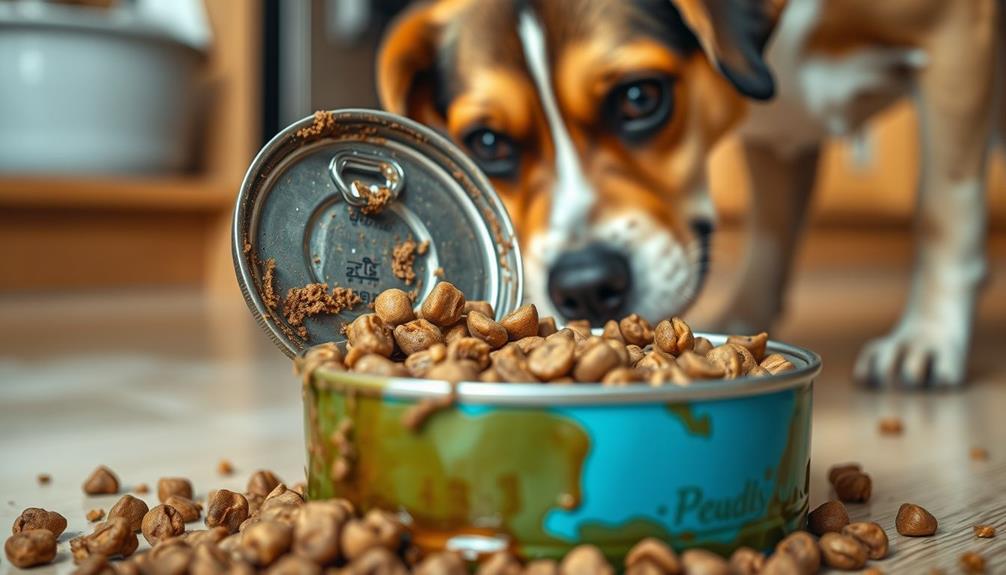
When contemplating wet dog food, you should be aware of potential nutritional imbalances that can arise from relying solely on these diets.
Additionally, the high moisture content can create a breeding ground for bacteria if food isn't stored properly after opening.
It's important to keep in mind that just like mastering the art of bug out bags, proper preparation and knowledge about the food you choose for your dog are essential for their health.
It's vital to balance these risks with your dog's overall health needs and feeding habits.
Nutritional Imbalance Concerns
Wet dog food can seem like a convenient option, but it often raises concerns about nutritional imbalances. While it provides high moisture content and palatability, it may lack essential nutrients or offer imbalanced ratios of protein, fats, and carbohydrates compared to raw diets. Many commercial wet foods contain fillers and artificial additives, which might lead to long-term nutritional deficiencies if used exclusively.
Additionally, understanding your dog's specific dietary needs is essential for their health and well-being, much like establishing a budget for financial health.
The quality of ingredients in wet food can also vary considerably. Lower-quality proteins and excessive carbohydrates may not meet your dog's dietary needs, resulting in potential health issues. Unlike raw diets, which you can tailor to specific nutrient profiles, most wet foods don't offer the same level of customization. This lack of personalization can lead to inadequate nutrient intake for some dogs.
If your dog is on a long-term wet food diet, watch for signs of nutritional imbalance, such as poor coat condition, low energy, or weight fluctuations. These symptoms highlight the importance of monitoring their overall health and diet closely.
Ensuring your dog receives a balanced diet is essential for their well-being, so consider all options carefully.
Bacterial Contamination Risks
Many pet owners overlook the potential risks associated with wet dog food, particularly bacterial contamination. A 2017 study revealed that about 10% of commercial wet dog foods tested positive for Salmonella, demonstrating the hazards that can arise from improper handling.
The high moisture content in wet food can create a breeding ground for pathogens like Salmonella and Listeria, especially if you leave the food out at room temperature for too long. It's vital to be aware of the importance of proper food handling, similar to how mammography aims to detect breast cancer early for better treatment outcomes in humans.
Unlike raw foods, which often have strict handling protocols, wet dog food typically has less stringent safety standards. This lower oversight can raise concerns about quality control and the presence of harmful bacteria. To keep your furry friend safe, always refrigerate opened wet food promptly and stick to expiration dates.
It's important for pet owners to be vigilant about these risks. By taking proper precautions, you can minimize the chances of bacterial contamination and safeguard your dog's health and safety.
Risks of Raw Dog Food
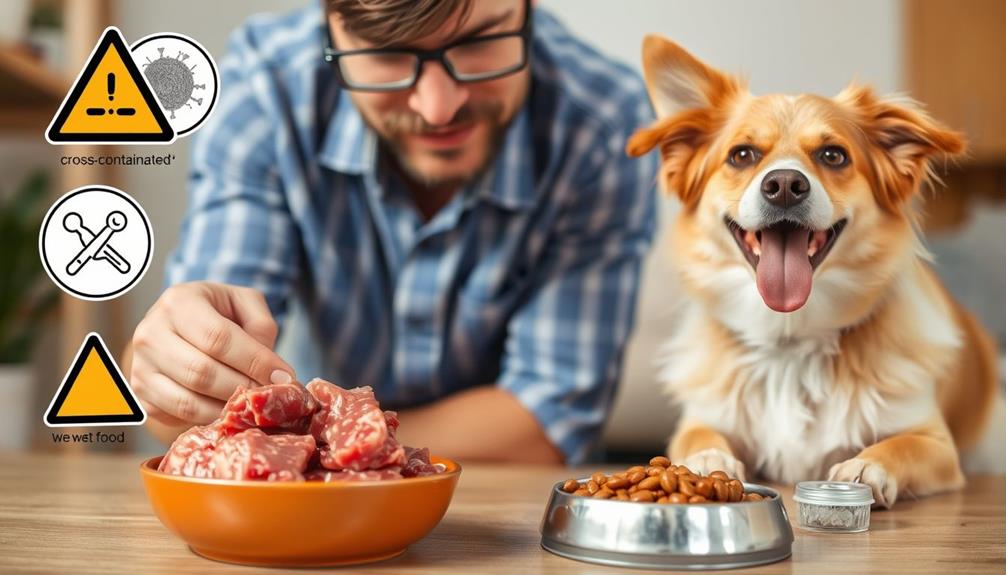
Feeding your dog a raw food diet can carry significant risks that you need to contemplate. One of the biggest concerns is the potential for bacterial infections. Raw dog food often contains pathogens like Salmonella and E. coli, which can affect both your dog and anyone handling the food. Studies reveal that about 20% of raw pet food products harbor harmful bacteria, raising serious food safety concerns.
Additionally, similar to how individuals with Borderline Personality Disorder may experience instability in emotional regulation, the raw diet can lead to unpredictable health outcomes if not carefully managed.
Moreover, improperly balanced raw diets can lead to nutritional deficiencies. It takes expertise to get the right proportions of protein, fats, vitamins, and minerals, and many pet owners struggle with this aspect. Without proper balance, your dog's health may suffer.
If you have young children, pregnant women, or immunocompromised individuals in your home, the risks increase. Feeding your pet raw diets can expose them to zoonotic diseases, further complicating your family's health.
Veterinary associations, including the American Veterinary Medical Association, generally advise against raw diets due to these health risks and the lack of regulatory oversight in raw pet food production. Considering these factors, you should carefully weigh the risks before opting for a raw food diet for your dog.
Nutritional Comparison
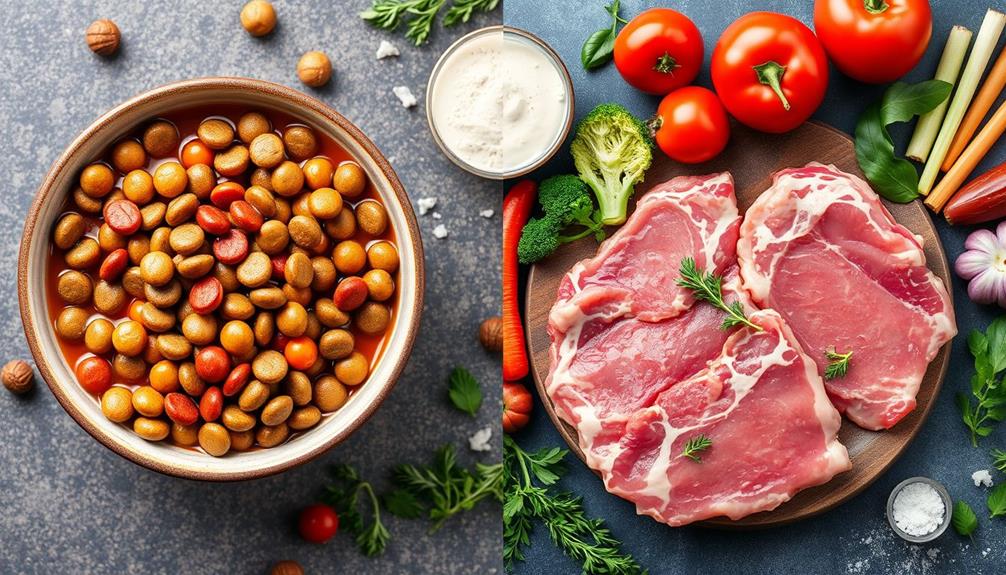
When comparing wet food and raw food for dogs, you'll want to take into account nutritional balance, ingredient quality, and how well your dog can digest and absorb the nutrients.
Wet food usually meets established standards for nutritional balance, while raw diets require more planning to guarantee they provide everything your dog needs.
Additionally, some pet owners explore options like essential oils for overall wellness to support their dog's health.
Understanding these differences can help you make an informed choice that supports your dog's health.
Nutritional Balance Assessment
Evaluating the nutritional balance between wet food and raw food for dogs is essential for ensuring your pet's health.
Wet food typically provides a consistent nutritional profile that adheres to AAFCO standards, ensuring it contains the necessary nutrients your dog needs. This type of food often features real meat as its primary ingredient, delivering high-quality protein sources to support muscle health.
On the other hand, raw food diets can offer high levels of protein and natural enzymes beneficial for digestion, but they require careful planning. If not managed properly, raw diets may lead to nutritional imbalances and deficiencies that could affect your dog's well-being.
While some studies indicate that raw diets might enhance gut microbiome diversity, the variability in ingredient quality can be a concern.
Ultimately, both wet and raw food types need to be assessed based on your dog's individual needs.
Wet food generally provides a more reliable nutritional balance, while raw food diets can pose risks if not crafted with precision. It's vital to weigh these factors to make the best choice for your furry friend.
Ingredient Quality Differences
Ingredient quality plays an essential role in the nutritional comparison between wet and raw food for dogs. When considering what to feed your pup, it's vital to evaluate the ingredients used, as this can greatly impact their health. Here are some key differences:
- Moisture Content: Wet food contains high moisture, aiding hydration and palatability, while raw food focuses on fresh ingredients like meat and vegetables.
- Nutritional Balance: Wet food is often formulated to meet AAFCO standards, guaranteeing essential vitamins and minerals, whereas raw food requires careful preparation to avoid deficiencies.
- Additives: Commercial wet food may include fillers and artificial additives, while raw food advocates highlight the importance of sourcing high-quality, whole food ingredients.
- Nutritional Density: Raw diets can offer higher levels of antioxidants compared to processed wet food, but make sure you handle raw ingredients safely to avoid contamination.
Ultimately, the ingredient quality in both wet and raw food can vary greatly, affecting your dog's nutrition. By carefully considering these aspects, you can make an informed choice that best supports your canine companion's health.
Digestibility and Absorption Rates
Understanding ingredient quality sets the stage for examining digestibility and absorption rates in dog food. When it comes to wet food, it typically boasts a higher moisture content, aiding hydration and making digestion easier. You'll find that the digestibility of wet food can reach around 90% or even higher.
In contrast, raw diets can vary in digestibility, relying heavily on the balance of ingredients. If formulated correctly, these diets can also offer high digestibility.
Raw foods often contain natural enzymes that may boost nutrient absorption, an advantage over processed wet food, which might lose these beneficial enzymes during manufacturing. Additionally, research indicates that dogs on raw diets often experience enhanced gut microbiome diversity, which positively influences both nutrient absorption and overall digestion.
When considering protein, the protein digestibility corrected amino acid score (PDCAAS) for wet and raw foods can vary widely. Generally, high-quality proteins are more easily absorbed in both types.
Ultimately, the choice between wet and raw food should reflect your dog's specific needs for digestibility and nutrient absorption, ensuring they get the most out of their meals.
Cost Analysis
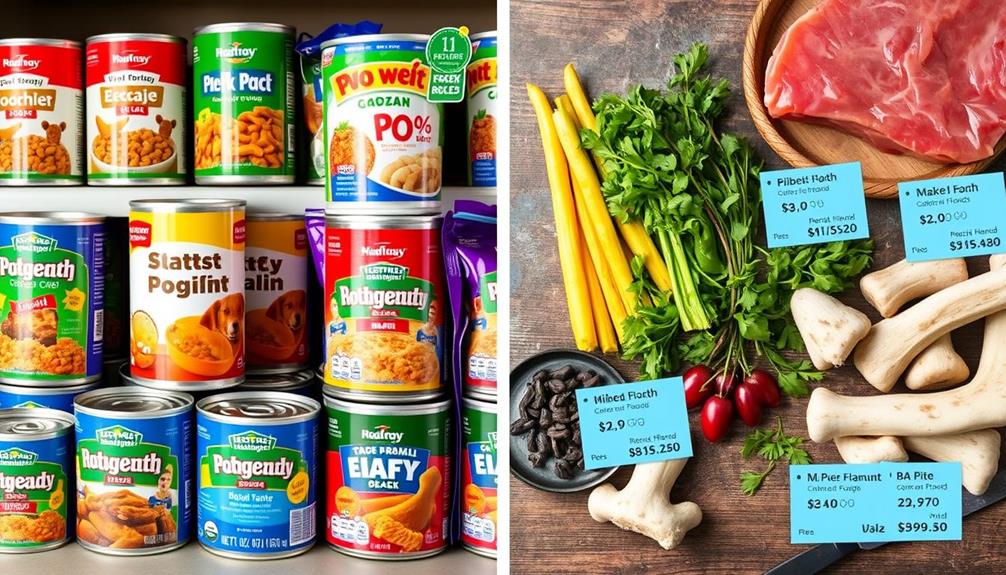
When contemplating the cost of feeding your dog, you'll find that wet food generally falls between dry kibble and raw diets regarding expense.
For dog owners looking to make informed choices, here's a cost analysis of each option:
- Wet Food: Typically ranges from $1 to $3 per can, but premium brands can cost up to 50% more.
- Dry Kibble: Buying in bulk can lead to significant savings, making it the most cost-effective option.
- Raw Food: Prices can range from $2 to $5 per pound, making it one of the pricier choices available.
- Homemade Diets: Costs vary based on ingredients, but they can be less expensive than raw diets while still providing tailored nutrition.
Ultimately, the choice you make impacts not just your dog's health but also your wallet.
Wet food may be a more affordable option than raw food, but it's crucial to evaluate your budget and your dog's specific dietary needs when making this decision.
Personal Preferences
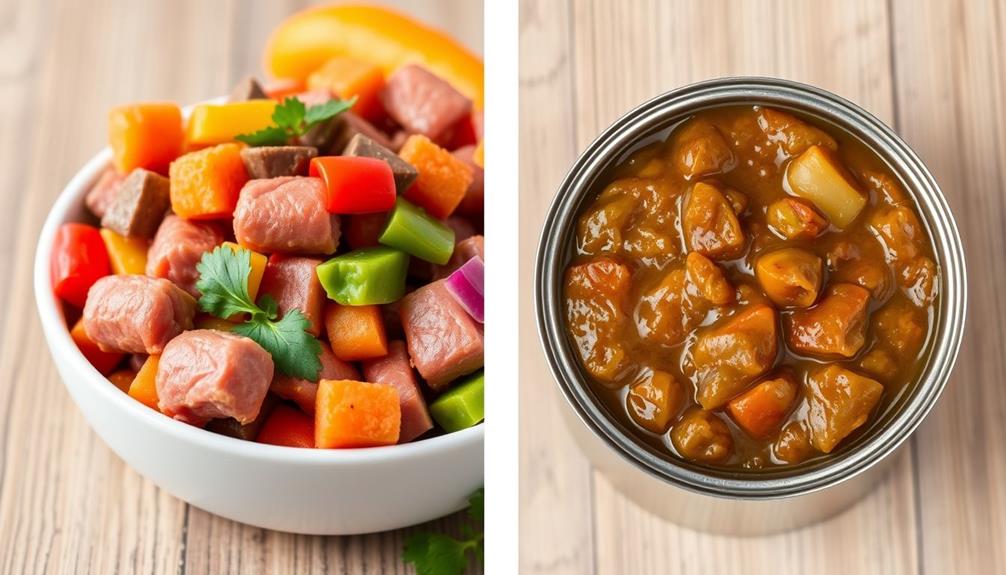
Many dogs have distinct personal preferences that can greatly affect their choice between wet and raw food. Many pups prefer the taste and texture of wet food, thanks to its higher moisture content and enticing aroma. If you have a picky eater, you might find that wet food is more palatable, encouraging them to eat when other options fail. Its softer consistency can be easier for dogs to chew, making mealtime less of a struggle.
Wet food also provides a variety of flavors and formulations, catering to individual tastes and enhancing the overall dining experience. This variety can make it simpler to introduce new ingredients or medications, as wet food blends easily with other items.
On the other hand, raw food requires careful balancing and preparation, which may not appeal to every dog.
Additionally, the routine associated with wet food can create a sense of familiarity for your pets, as it's typically served in a more consistent manner. If your dog enjoys a routine, they might be more inclined to stick with wet food over the variability of raw diets.
Understanding your dog's preferences can help you make an informed choice.
Specialized Diets
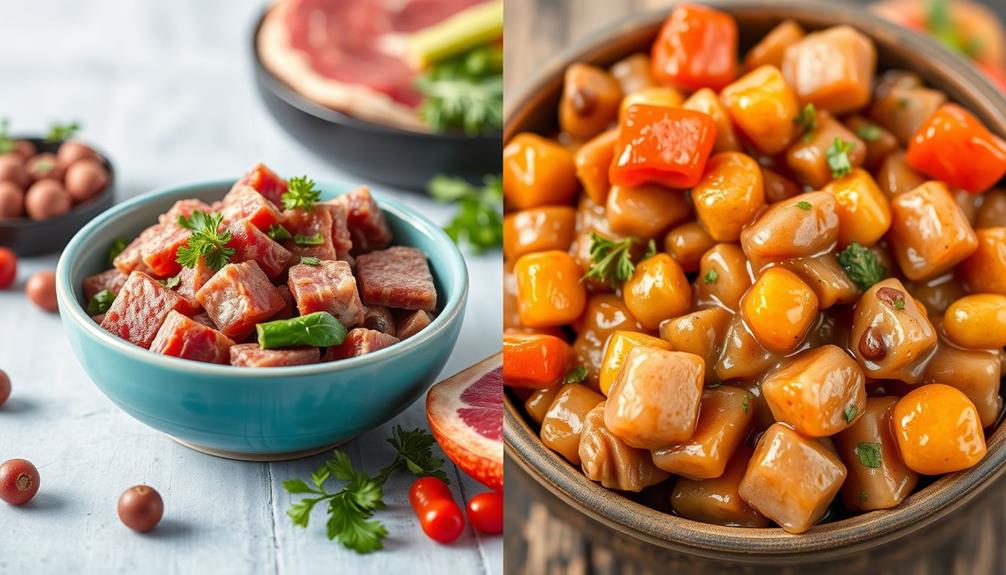
Specialized diets play an essential role in managing your dog's health and addressing specific conditions. When you tailor your dog's nutrition, it can greatly improve their well-being.
Here are some key points to reflect on about specialized diets:
- Address Health Issues: Specialized diets can help manage allergies, obesity, diabetes, and kidney disease.
- Limited Ingredient Diets: For dogs with food sensitivities, limited ingredient diets (LIDs) minimize the risk of allergic reactions and digestive issues.
- Texture Matters: Dogs with dental problems may benefit from the softer texture of wet food, while those needing weight management might thrive on high-protein, low-carb raw diets.
- Consult Your Veterinarian: It's vital to consult your veterinarian when evaluating specialized diets, as they can provide tailored advice based on your dog's health status and dietary needs.
Consulting With Veterinarians
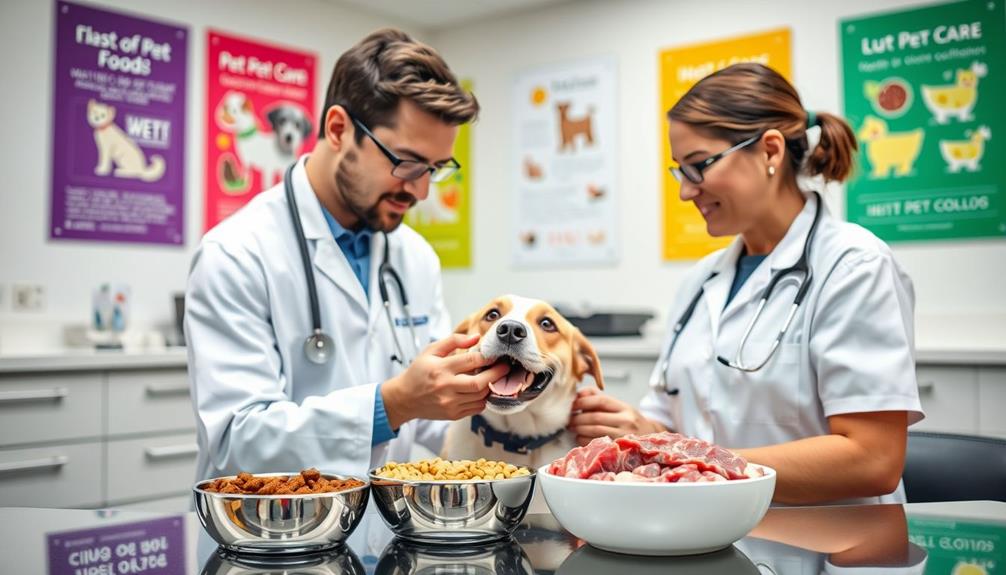
Consulting with a veterinarian is an important step before making any significant changes to your dog's diet, especially when considering a raw food option. A vet can help you guarantee that your dog's nutritional balance remains intact and address any specific health concerns.
Many veterinarians express reservations about raw food diets, highlighting risks like bacterial contamination and nutritional imbalances that could negatively impact both your dog and your family.
By consulting with a veterinarian, you can gain insight into proper handling and preparation techniques needed for raw food. This guidance is essential to minimize health risks associated with feeding your dog raw meals.
Additionally, your vet can help identify any potential allergies or sensitivities your dog may have, suggesting suitable alternatives if needed.
It's also critical to schedule regular veterinary check-ups to monitor the health impacts of any dietary changes you make, whether you choose raw or wet food.
This proactive approach guarantees your dog's well-being and allows you to make informed decisions about their nutrition.
Frequently Asked Questions
Is Raw Food or Wet Food Better for Dogs?
When choosing for your dog, consider their individual needs. Raw food might boost energy and coat health, while wet food offers hydration and palatability. Weigh the benefits against potential risks to find the best fit.
What Is the Healthiest Food to Feed Your Dog?
Imagine your dog's tail wagging with excitement as you serve a meal that's both nutritious and delicious. You'll want to choose a balanced diet that meets their specific needs, ensuring they thrive and stay healthy.
Do Vets Recommend a Raw Diet for Dogs?
Most vets don't recommend raw diets for dogs due to health risks like bacterial contamination. They suggest you discuss any dietary changes with them first to guarantee your dog's nutrition and safety are prioritized.
Is Canned Dog Food as Good as Raw?
Canned dog food offers hydration and convenience, while raw provides high protein and freshness. Both have their merits, but you need to contemplate your dog's health, preferences, and your ability to manage nutritional balance effectively.
Conclusion
Ultimately, the choice between wet and raw dog food boils down to your dog's unique needs and your personal preferences. Both options have their perks and pitfalls, so weighing them carefully is essential. It's like choosing between a gourmet feast and a wild hunt—each has its allure. Don't forget to consult your vet to guarantee your furry friend gets the best nutrition possible. Your pup deserves nothing less than the absolute best, after all!






